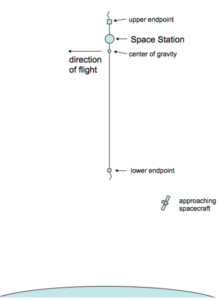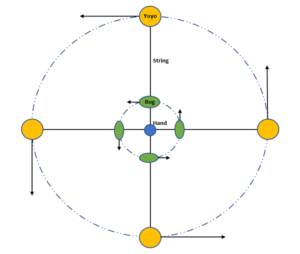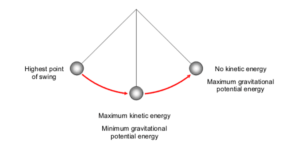Abstract
A concept called the skyhook might revolutionize the way humans travel in space very soon. Functioning as cables thousands of kilometers (km) long that orbit the Earth, the skyhook can latch onto outbound spacecrafts at the edge of Earth’s atmosphere and move them away along the cable, bypassing the immense energy that it takes for a traditional rocket to enter orbit. With multiple skyhooks serving as critical space infrastructure, human interplanetary travel can become very cheap and time effective. Mars and the moon could be colonized in a matter of years, and any transport of goods and people in space would become extremely efficient. A well-designed system of skyhooks can propel humanity into a spacefaring civilization within the next 100 years. Currently science fiction, skyhooks can become a reality with advancements in synthetic fiber and nanotube technology, as well as investments from multiple governments or private companies interested in breaching the final frontier.
Introduction
You flip through the vacation catalogs facing a dilemma. Should you spend this summer visiting the new Mars colony or the floating cities of Venus? You’ve already been to the mining districts of the Moon; it was mediocre at best. The food wasn’t great and the constant hopping around was tiring, but the views of Earth were breath-taking. After much internal debate, you decide to travel to Venus. Its thick atmosphere allows for less dense materials to float, much like helium balloons on Earth its cities float in Venus’ carbon dioxide-rich skies [1]. Excited, you buy a ticket online just in time to catch the next flight. Arriving at the local spaceport, you check in your luggage, put on a light spacesuit, and sink into your seat as your spacecraft departs Earth.
Such a scenario is not possible with today’s technology. We are all bound by Earth’s immense gravity because it takes a tremendous amount of energy to escape our planet’s grasp. In a way, Earth acts as a prison for humanity, limiting our access to other planets and their vast supplies of raw materials. Furthermore, our restriction to one planet makes us vulnerable to extinction level events.
Nonetheless, we have tried to breach the final frontier with new advancements and clever engineering. Currently, the only form of technology that allows humans to get a taste of space travel is the rocket, but it is extremely inefficient in transporting goods into space. With renewed public interest in space exploration and threats like climate change and nuclear warfare threatening humanity, a new concept for space infrastructure known as the skyhook can revolutionize the way we travel in space, extending the reach of the human species and unlocking doors to immense scientific experiments in space.
Why Today’s Rockets Are Not Good Enough
Since the dawn of space exploration in the 1950s, humans have utilized one main method to escape the gravitational pull of Earth: rocket propulsion. Arguably one of the most complex machines engineered by humanity, the rocket gives us the ability to explore the final frontier.
However, there’s a catch. Like all other processes in engineering and physics, current space travel is dictated by limitations. Three variables control a rocket’s performance: the rocket’s speed, its energy, and its propellant mass fraction—the ratio between the mass of fuel and the total rocket mass [2]. Achieving total optimization of the three variables is difficult and costly. Specifically, the propellant mass fraction limits the maximum range at which our rockets can reach.
The laws of physics have, annoyingly, required the velocity and energy required for a rocket to escape Earth’s gravity and reach a destination to be set in stone. With two of the three variables being a deadened, the only variable engineers can control is the propellant mass fraction, but the range at which the fraction can change is very small. This is where the trickiness comes in, and it explains why space travel is severely limited by current technological capabilities. The propellant mass fraction dictates that as you increase the cargo of the rocket, you must significantly increase the amount of propellant used to achieve the velocity and energy needed. In English, this means that in order to bring a small rover to Mars, the rocket carrying the payload might be composed of nearly 90% propellant, meaning only 10% of the rocket is the actual structure and cargo [2]. Saturn V, the rocket that put the first man on the moon, used 2,722,700 kg of propellant, the equivalent weight of 500 adult elephants, to carry 183,400 kg of structural mass, or the weight of 33 adult elephants at lift off, which was about 6% of the total mass of the rocket. The final materials that landed on the moon weighed only 41000 kg, or the weight of 7 adult elephants, about 1.4% of the total mass [3].
It is virtually impossible to design a rocket composed of more than 95% propellant mass without the rocket failing. The total weight of the rocket becomes so heavy that it cannot beat Earth’s gravity. This is why there are no Mars colonies or Moon bases – rockets output huge amounts of energy to deliver very little materials. Interplanetary travel with rockets is costly and time consuming, especially since only 2-3% of the rocket is the actual cargo itself. It is clear that another method of space travel is needed for humanity to establish a strong presence in space.
The Skyhook: How It Works
While rocket propulsion cannot sustain long-term ambitions for space exploration, you shouldn’t give up your dream of living on Mars just yet. Skyhooks might revolutionize the future of interplanetary travel and expedite the colonization of Mars and beyond. A skyhook is essentially a really long cable, approximately ranging from 1000 km to 4000 km long, that orbits the Earth. It remains completely vertical with respect to the Earth’s surface, and is gravity-gradient stabilized, meaning the skyhook can be balanced in orbit vertically with its own mass distribution and Earth’s gravity field alone without the use of engines [4],[5]. Figure 1 shows the skyhook in orbit.


The law of conservation of energy states that energy cannot be created or destroyed, but it can be transferred from one form to another. The skyhook is dictated by two forms of energy: kinetic and potential energy. Kinetic energy relates to movement. An object has more kinetic energy when it moves faster, and less kinetic energy when it moves slower. Potential energy correlates to the potential to move. In the case of space travel, an object has more potential energy the farther it is from Earth, since it has more potential to fall back onto Earth’s surface due to gravity. Because energy is always conserved, a loss in kinetic energy results in a gain in potential energy, and vice versa [7]. Conservation of energy can be visualized by considering a simple pendulum shown in Figure 3. At the middle of the pendulum’s swing, the ball moves with a maximum speed. Therefore, it has the most kinetic energy and the least potential energy, since there is no remaining potential to increase the speed. At the end of the swing, the ball is momentarily stationary, meaning it has no kinetic energy and has the most potential energy to increase its speed. The skyhook’s brilliance is that its core engineering principle is the simple law of conservation of energy. There is no rocket science involved – no need for multi-stage rockets involving thermodynamics, heat transfer, and fluid dynamics, or complicated orbital maneuvers to get things into space. The skyhook uses a basic physics law to replace our complex methods of space travel.

The best part about the skyhook is that it is possible to build one very soon. Advanced synthetic fibers like carbon nanotubes four times stronger than Kevlar exist today, making skyhooks very feasible. With some clever engineering, the current centimeter long carbon nanotubes could be scaled up to be the 4000 km length needed for skyhooks[9]. The manufacturing process involves building the lower end of the skyhook on Earth and placing it in orbit. Then, the rest of construction can be performed in space, much like the manufacturing process of the International Space Station.
Benefits
The biggest benefit of the skyhook is that it can send more cargo into space with significantly less time and cost. Spacecrafts that travel from Earth to the skyhook can carry more materials with less propellant because they do not have to enter orbit, which requires a large amount of energy to reach. For reference, a rocket must achieve a speed of around 7 km/s to enter orbit. Reducing the speed by a mere 800 m/s makes it possible to triple the mass of the cargo onboard and reduce costs by 67%, because the rocket does not have to carry more propellant onboard and can allocate the free space for more cargo [4]. Once transferred to the upper end of the skyhook, the spacecraft has more velocity and can enter a direct path to the moon, Mars, or other planets with much less energy than a traditional rocket would require [10].
In addition to more accessible space transport and travel, they also offer the possibility for a new space infrastructure.The modern, globalized transportation network allows us to fly from Los Angeles to New York in 6 hours, transport tons of consumer goods across the Atlantic, or drive a couple blocks down the road to pick up groceries. The same solution can be applied to outer space for efficient interplanetary travel. Multiple skyhooks can be placed around Earth’s orbit to rapidly send payloads into space. Smaller variants can also be built in orbit around the moon and Mars to accelerate human travel between the planets, effectively acting as space airports for the movement of goods and people. Deploying skyhooks around asteroids will allow for easy access to raw materials and metals, providing more building materials to expand existing space infrastructure.
Through the skyhook, we can unlock more unknowns of the universe and exponentially increase our knowledge about physics, astronomy, and much more. We can visit exoplanets that have similar conditions to Earth, orbit other stars to study their behavior, or enter foreign solar systems and potentially discover other life forms. But why stop there? If material science advances to the point where 100,000 km, 500,000 km, or 1,000,000 km skyhooks can be built, we can even visit other galaxies one day, applying the same skyhook concept by placing “galaxy-hooks” in orbit around the center of our galaxy.

Drawbacks
The skyhook will be a monumental project with a very hefty price tag. For reference, the International Space Station was a 30-year, multinational effort that cost over $100 billion to build [11]. The skyhook will cost significantly more than the ISS in terms of price and time, and will require close collaboration between most nations on Earth. Such a drawback is inevitable in most large infrastructure projects. The United States Interstate Highway System project, which provided 43,000 miles of interstate highways across the country in the 1950s, cost $130 billion and took 62 years to complete [12]. Although incredibly costly and time consuming to complete, today you can drive from California to New York in a little over 3 days because of the Interstate Highway System. The transportation of goods and movement of people in the US became cheaper and easier due to better infrastructure. Space infrastructure will work in the same fashion.The initial costs to establish the “space highway system” of skyhooks will be astronomically large. However, once in place, it will make the transport of people, goods, and ideas much more efficient.
Another drawback is the possibility for terrorist attacks or sabotage. If a skyhook loses enough kinetic energy, it will fall back to the Earth and cause catastrophic damage if it lands on a densely populated metropolitan area. A group of malicious individuals can potentially use a skyhook to execute terrorist attacks. Security systems and space patrols might be needed to ensure the safety of the skyhook and the people living on the planet over which the skyhook orbits, much like how US interstate highway patrol officers enforce speed limits or airport security TSA agents filter out weapons being transported onto planes.
The Future of Space Travel
Since the end of the Cold War, limited advancements have been made in space travel technologies. With the recent resurrection of public and governmental interests in interplanetary exploration, however, perhaps the skyhook can become a reality with more investment and scientific improvements on synthetic fibers. Once completed, the skyhook will dramatically cheapen the cost of space travel, allow more efficient transportation of cargo, and throw open the doors to a new age of space exploration.By successfully sending people to the moon, humanity left its comfortable cradle, finally learning to walk. We must now learn to run – to Mars, Venus, and beyond. We must ask ourselves what kind of civilization we want to become – one where we’re vulnerable to asteroid strikes, overpopulation, and extinction, or one where we flourish as a multi-planet varying species. With more investment and interest, the skyhook might no longer be a concept of science fiction. The question is when do we realize and act on our potential?
Further Reading
NASA’s idea of an electrodynamic skyhook:
NASA paper detailing how skyhooks can be used to colonize Phobos, one of Mars’ moons:
Wired article about sub-orbital spacecrafts:
References
[1] P. Shadbolt, “NASA’s plan for our next world: a cloud city over Venus,” CNN, 03-Jan-2015. [Online]. Available: https://www.cnn.com/2014/12/23/tech/innovation/tomorrow-transformed-venus-blimp-city/index.html. [Accessed: 28-Feb-2020].
[2] P. Shadbolt, “NASA’s plan for our next world: a cloud city over Venus,” CNN, 03-Jan-2015. [Online]. Available: https://www.cnn.com/2014/12/23/tech/innovation/tomorrow-transformed-venus-blimp-city/index.html. [Accessed: 28-Feb-2020].
[3] E. Sarmont, “Why do Rockets Cost so Much?,” Opening the High Frontier, 13-Oct-2018. [Online]. Available: http://www.high-frontier.org/rockets-cost-much/. [Accessed: 28-Feb-2020].
[4] “Skyhooks and Space Elevators,” Skyhooks and Space Elevators, 13-Oct-2018. [Online]. Available: https://skyhooksandspaceelevators.wordpress.com/. [Accessed: 28-Feb-2020].
[5] R. B. Kershner and R. E. Fischell, “Gravity-Gradient Stabilization of Earth Satellites,” IFAC Proceedings Volumes, 01-Jul-2017. [Online]. Available: https://www.sciencedirect.com/science/article/pii/S147466701769092X. [Accessed: 28-Feb-2020].
[6] E. Sarmont, “Skyhooks and Space Elevators,” Opening the High Frontier, 13-Oct-2018. [Online]. Available: http://www.high-frontier.org/skyhooks-and-space-elevators/. [Accessed: 28-Feb-2020].
[7] “Energy Transformation for a Pendulum,” The Physics Classroom. [Online]. Available: https://www.physicsclassroom.com/mmedia/energy/pe.cfm. [Accessed: 28-Feb-2020].
[8] “Conservation on Energy, Kinetic Energy, and Heat Transfer,” Physics Revision. [Online]. Available: https://marthahphysics.weebly.com/conservation-on-energy-kinetic-energy-and-heat-transfer.html. [Accessed: 28-Feb-2020].
[9] B. Wang, “Industrial Scale Production of Cambridge Carbon Nanotube Tethers Will Enable Hypersonic Skyhooks and Better Moon and Mars Space Elevators,” nextbigfuture, 07-Apr-2017. [Online]. Available: https://www.nextbigfuture.com/2009/01/industrial-scale-production-of.html. [Accessed: 28-Feb-2020].
[10] “L5 News: The Rocket / Skyhook Combination,” National Space Society, Mar-1983. [Online]. Available: https://space.nss.org/l5-news-the-rocket-skyhook-combination/. [Accessed: 28-Feb-2020].
[11] M. R. Nichols, “What Did It Take to Build the International Space Station?,” Astronaut, 11-Oct-2017. [Online]. Available: https://astronaut.com/take-build-international-space-station/. [Accessed: 28-Feb-2020].
[12] “Highway History,” U.S. Department of Transportation. [Online]. Available: https://www.fhwa.dot.gov/interstate/faq.cfm. [Accessed: 28-Feb-2020].
[13] E. Sarmont, “Visions of the Future,” Opening the High Frontier, 13-Oct-2018. [Online]. Available: http://www.high-frontier.org/visions-of-the-future/. [Accessed: 28-Feb-2020].



